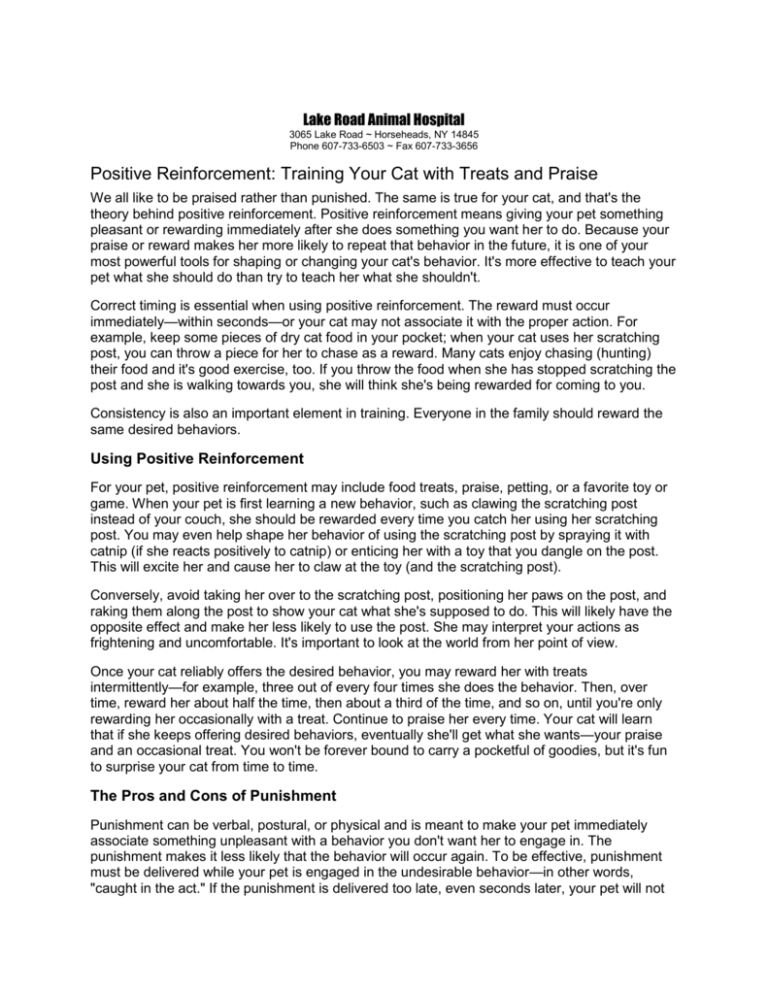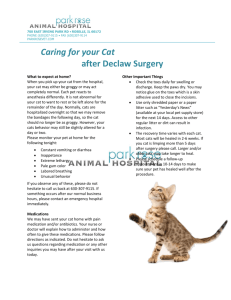
Lake Road Animal Hospital
3065 Lake Road ~ Horseheads, NY 14845
Phone 607-733-6503 ~ Fax 607-733-3656
Positive Reinforcement: Training Your Cat with Treats and Praise
We all like to be praised rather than punished. The same is true for your cat, and that's the
theory behind positive reinforcement. Positive reinforcement means giving your pet something
pleasant or rewarding immediately after she does something you want her to do. Because your
praise or reward makes her more likely to repeat that behavior in the future, it is one of your
most powerful tools for shaping or changing your cat's behavior. It's more effective to teach your
pet what she should do than try to teach her what she shouldn't.
Correct timing is essential when using positive reinforcement. The reward must occur
immediately—within seconds—or your cat may not associate it with the proper action. For
example, keep some pieces of dry cat food in your pocket; when your cat uses her scratching
post, you can throw a piece for her to chase as a reward. Many cats enjoy chasing (hunting)
their food and it's good exercise, too. If you throw the food when she has stopped scratching the
post and she is walking towards you, she will think she's being rewarded for coming to you.
Consistency is also an important element in training. Everyone in the family should reward the
same desired behaviors.
Using Positive Reinforcement
For your pet, positive reinforcement may include food treats, praise, petting, or a favorite toy or
game. When your pet is first learning a new behavior, such as clawing the scratching post
instead of your couch, she should be rewarded every time you catch her using her scratching
post. You may even help shape her behavior of using the scratching post by spraying it with
catnip (if she reacts positively to catnip) or enticing her with a toy that you dangle on the post.
This will excite her and cause her to claw at the toy (and the scratching post).
Conversely, avoid taking her over to the scratching post, positioning her paws on the post, and
raking them along the post to show your cat what she's supposed to do. This will likely have the
opposite effect and make her less likely to use the post. She may interpret your actions as
frightening and uncomfortable. It's important to look at the world from her point of view.
Once your cat reliably offers the desired behavior, you may reward her with treats
intermittently—for example, three out of every four times she does the behavior. Then, over
time, reward her about half the time, then about a third of the time, and so on, until you're only
rewarding her occasionally with a treat. Continue to praise her every time. Your cat will learn
that if she keeps offering desired behaviors, eventually she'll get what she wants—your praise
and an occasional treat. You won't be forever bound to carry a pocketful of goodies, but it's fun
to surprise your cat from time to time.
The Pros and Cons of Punishment
Punishment can be verbal, postural, or physical and is meant to make your pet immediately
associate something unpleasant with a behavior you don't want her to engage in. The
punishment makes it less likely that the behavior will occur again. To be effective, punishment
must be delivered while your pet is engaged in the undesirable behavior—in other words,
"caught in the act." If the punishment is delivered too late, even seconds later, your pet will not
associate the punishment with the undesired behavior. The punishment will seem totally
unpredictable to her.
Remember, cats do not act out of spite or revenge and they don't have a moral sense of right
and wrong. Never use physical punishment that involves discomfort or pain; in addition to being
inhumane, such punishment may cause your cat to bite, defend herself, or resort to other
undesirable behaviors. For example, holding your cat's neck skin and shaking her may result in
a frightened cat who scratches or bites to defend herself.
Also, your cat might associate the punishment with other stimuli, including people, who are
present at the time the punishment occurs. For example, a cat who is punished for getting too
close to a new baby may become fearful of, or aggressive to, that baby—or to other babies.
That's why physical punishment is not only bad for your cat, it's also bad for you and others.
It's easy to understand that punishment delivered by you may erode your cat's trust and frighten
her. That's why punishment is most effective when it does not come directly from you. For
example, if your cat enjoys scratching the couch, you may apply special double-sided tape to
those surfaces. Cats rarely like sticky paws. Thus your cat perceives the couch, and not you, to
be delivering the punishment. In this way, too, your cat is more likely to avoid the undesirable
behavior even when you're not around. However, it is critical that while discouraging
undesirable behaviors, you help your cat understand what you want her to do and provide
appropriate outlets for her normal cat behaviors. (For more information on specific tools and
techniques to keep your cat away from particular places or to stop her from engaging in certain
behaviors, see our tip sheet on Using Aversives to Modify Your Cat's Behavior.)
One of the reasons that cats are such fun companions is that when they're not sleeping, many
of them enjoy playing. Playing with your cat will not only help her physical and behavioral
development, but it can also reduce undesirable behaviors. Be sure your cat has safe toys to
play with by herself, and don't underestimate the power of playing with your cat to strengthen
the bond between you and enhance the quality of life for both of you.
© 2002. Adapted from material originally developed by applied animal behaviorists at the Dumb Friends League, Denver, Colorado. All rights
reserved.
Copyright © 2004 The Humane Society of the United States. All rights reserved.








